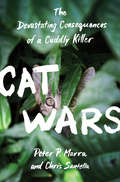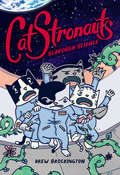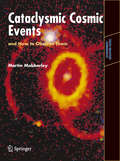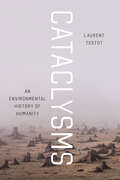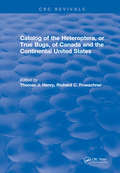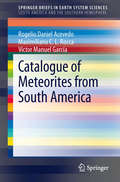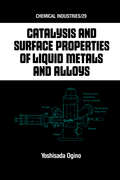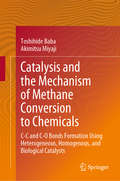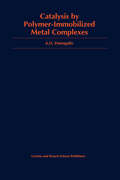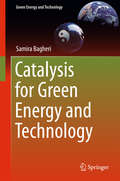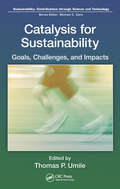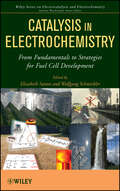- Table View
- List View
Cat Wars: The Devastating Consequences of a Cuddly Killer
by Peter P. Marra Chris SantellaIn 1894, a lighthouse keeper named David Lyall arrived on Stephens Island off New Zealand with a cat named Tibbles. In just over a year, the Stephens Island Wren, a rare bird endemic to the island, was rendered extinct. Mounting scientific evidence confirms what many conservationists have suspected for some time--that in the United States alone, free-ranging cats are killing birds and other animals by the billions. Equally alarming are the little-known but potentially devastating public health consequences of rabies and parasitic Toxoplasma passing from cats to humans at rising rates. Cat Wars tells the story of the threats free-ranging cats pose to biodiversity and public health throughout the world, and sheds new light on the controversies surrounding the management of the explosion of these cat populations.This compelling book traces the historical and cultural ties between humans and cats from early domestication to the current boom in pet ownership, along the way accessibly explaining the science of extinction, population modeling, and feline diseases. It charts the developments that have led to our present impasse--from Stan Temple's breakthrough studies on cat predation in Wisconsin to cat-eradication programs underway in Australia today. It describes how a small but vocal minority of cat advocates has campaigned successfully for no action in much the same way that special interest groups have stymied attempts to curtail smoking and climate change.Cat Wars paints a revealing picture of a complex global problem--and proposes solutions that foresee a time when wildlife and humans are no longer vulnerable to the impacts of free-ranging cats.
CatStronauts: Slapdash Science (CatStronauts #5)
by Drew BrockingtonIn the fifth book in the CatStronauts graphic novel series, Pom Pom pushes her experiments to the limit on the International Space Station, while the cats at Mission Control take a much needed break. What could possibly go wrong? While the cats are away, the other cats will play! Flight Director Maisy is off on her first vacation in years, and World's Best Scientist is looking for a secret vacation of his own. But while the party picks up on Earth, the CatStronauts are trying to get all of their work on the International Space Station done in record time. So when disaster strikes in space, the CatStronauts will have to fix everything without their trusty support team at Mission Control. In this full-color graphic novel, debut author/illustrator Drew Brockington pushes CatStronauts team further than ever, adding in mounds of experiments, teamwork, and tuna fish by the ton! <P><P> <i>Advisory: Bookshare has learned that this book offers only partial accessibility. We have kept it in the collection because it is useful for some of our members. Benetech is actively working on projects to improve accessibility issues such as these.</i>
Cataclysmic Cosmic Events and How to Observe Them (Astronomers' Observing Guides)
by Martin MobberleyThis book is about observing dramatic and often bizarre cosmic events. Observation of gamma ray bursts, cataclysmic variable star outbursts, distant supernovae, and even active galactic nuclei might be thought to be far beyond the range of amateur observers - but this is not the case. Recent technical developments in CCD equipment, powerful PCs, new observing and processing techniques, and professional satellite monitoring systems have opened a range of high-value niche areas of scientific astronomy to amateurs. Cataclysmic Cosmic Events and How to Observe them explains what these events are, what we know of their physics, and how amateur astronomers can observe them.
Cataclysms: A New Geology for the Twenty-First Century
by Michael RampinoIn 1980, the science world was stunned when a maverick team of researchers proposed that a massive meteor strike had wiped the dinosaurs and other fauna from the Earth 66 million years ago. Scientists found evidence for this theory in a “crater of doom” on the Yucatán Peninsula, showing that our planet had once been a target in a galactic shooting gallery. In Cataclysms, Michael R. Rampino builds on the latest findings from leading geoscientists to take “neocatastrophism” a step further, toward a richer understanding of the science behind major planetary upheavals and extinction events.Rampino recounts his conversion to the impact hypothesis, describing his visits to meteor-strike sites and his review of the existing geological record. The new geology he outlines explicitly rejects nineteenth-century “uniformitarianism,” which casts planetary change as gradual and driven by processes we can see at work today. Rampino offers a cosmic context for Earth’s geologic evolution, in which cataclysms from above in the form of comet and asteroid impacts and from below in the form of huge outpourings of lava in flood-basalt eruptions have led to severe and even catastrophic changes to the Earth’s surface. This new geology sees Earth’s position in our solar system and galaxy as the keys to understanding our planet’s geology and history of life. Rampino concludes with a controversial consideration of dark matter’s potential as a triggering mechanism, exploring its role in heating Earth’s core and spurring massive volcanism throughout geologic time.
Cataclysms: An Environmental History of Humanity
by Laurent TestotHumanity is by many measures the biggest success story in the animal kingdom; but what are the costs of this triumph? Over its three million years of existence, the human species has continuously modified nature and drained its resources. In Cataclysms, Laurent Testot provides the full tally, offering a comprehensive environmental history of humanity’s unmatched and perhaps irreversible influence on the world. Testot explores the interconnected histories of human evolution and planetary deterioration, arguing that our development from naked apes to Homo sapiens has entailed wide-scale environmental harm. Testot makes the case that humans have usually been catastrophic for the planet, “hyperpredators” responsible for mass extinctions, deforestation, global warming, ocean acidification, and unchecked pollution, as well as the slaughter of our own species. Organized chronologically around seven technological revolutions, Cataclysms unspools the intertwined saga of humanity and our environment, from our shy beginnings in Africa to today’s domination of the planet, revealing how we have blown past any limits along the way—whether by exploding our own population numbers, domesticating countless other species, or harnessing energy from fossils. Testot’s book, while sweeping, is light and approachable, telling the stories—sometimes rambunctious, sometimes appalling—of how a glorified monkey transformed its own environment beyond all recognition. In order to begin reversing our environmental disaster, we must have a better understanding of our own past and the incalculable environmental costs incurred at every stage of human innovation. Cataclysms offers that understanding and the hope that we can now begin to reform our relationship to the Earth.
Catalog of Unconfirmed Comets - Volume 1: 1600-1899 (Historical & Cultural Astronomy)
by Gary W. Kronk Maik MeyerThis catalog is the first in-depth investigation of comets that were reported since the 17th century, but not confirmed and subsequently lost. Volume I of this two-volume work covers objects observed between 1600 and 1899, a period that was dominated by visual observations and was experiencing a rapid evolution in science. The book uniquely combines the history and culture of comet hunting and discovery with modern tools of orbital mechanics to present a wholesome catalog of unconfirmed and suspected comets. Each case includes a presentation of the observations, a discussion about the observer (when possible), consideration of the historic context, and a conclusion as to the nature of the object. In most cases, the book presents material from original sources, including some never before published that were acquired from observatories, libraries, and historical societies around the world. Although some of these unconfirmed comets turned out to be misidentifications of planets or star clusters, fabrications, or poor observations of comets that were already being observed, the Authors did identify many objects that were likely real comets. In some cases, the Authors were even able to derive orbits for the first time. These observations may be valuable in the future, as they could prove to be observations of periodic comets still to be discovered.
Catalog of Unconfirmed Comets - Volume 2: 1900 to the Present (Historical & Cultural Astronomy)
by Gary W. Kronk Maik MeyerThis two-volume catalog is the first in-depth investigation of comets that were reported since the 17th century but not confirmed and subsequently lost. Volume 2 covers objects observed between 1900 and the present, a period that was dominated by photographic observations and the detection of much fainter objects. This book provides a distinctive blend of the historical and cultural aspects of comet hunting and discovery, along with the utilization of contemporary tools in orbital mechanics and data analysis. This comprehensive compilation offers a thorough catalog of unconfirmed comets. Each case encompasses a detailed presentation of observations, a discussion on the observer (when feasible), an examination of the historical context, and a conclusive analysis of the object's nature. The book predominantly showcases original material and photographs sourced from observatories, libraries, and historical societies worldwide; exposing a significant number ofillustrations that have never been previously published. While some of these unconfirmed comets were determined to be misidentifications of minor planets, artifacts caused by emulsion or optical effects, or inaccurate observations of comets that were already under observation, the Authors did manage to identify numerous objects that were likely genuine comets. These observations hold potential value for the future, as they could be observations of periodic comets yet to be formally identified. In a handful of instances, the Authors were also able to find new observations, which led to the calculation of orbits for the first time, enabling a formal announcement, or identifying suspected comets that were already known to be periodic comets.
Catalog of the Heteroptera or True Bugs, of Canada and the Continental United States
by Thomas J. HenryA primary aim of this catalog is to offer an accounting for each species as originally proposed and for the first usage only of all its name combinations (including valid names, synonymies, and misspellings) that have been published for our area. We follow the policy outlined by the 1985 Code of Zoological Nomenclature for nonmenclatorial proposes that a dissertation for an advanced educational degree is not published unless it satisfies the criteria present in Articles 8 and 9.
Catalogue of Meteorites from South America (SpringerBriefs in Earth System Sciences)
by Rogelio Daniel Acevedo Maximiliano C. L. Rocca Víctor Manuel GarcíaThe first Catalogue of Meteorites from South America includes new specimens never previously reported, while doubtful cases and pseudometeorites have been deliberately omitted. The falling of these objects is a random event, but the sites where old meteorites are found tend to be focused in certain areas, e. g. in the deflation surfaces in Chile's Atacama Desert, due to favorable climate conditions and ablation processes. Our Catalogue provides basic information on each specimen like its provenance and the place where it was discovered (in geographic co-ordinates and with illustrative maps), its official name, its classification type (class, and if applicable, weathering grade and shock stage), if it was seen falling or was found by chance, its total mass or weight, the institution where it is held, and the most important bibliographic references about it.
Catalogue of Selected Angiosperm Pollen Grains from Palaeogene and Neogene Sediments of India (Society of Earth Scientists Series)
by Surya Kant TripathiThis book summarizes the taxonomic details of selected fossil angiosperm pollen genera and species along with their affinity and occurrences in space and time. It provides information about the historical background of palynology from Palaeogene and Neogene sediments in India, general pollen morphology along with the terms commonly used in describing fossil angiosperm pollen and an overview of the Indian Tertiary sediments. A complete list of genera described in this book is given. It also includes a key for identification of Indian angiosperm genera as well as a description of selected fossil angiosperm pollen from India along with their Indian records, illustrations, locality, age and horizon from where these have been reported. In all 130 genera and 402 species have been dealt with. The names of genera and species are arranged alphabetically. The Discussion part includes a summarized account of palynofloras, their biostratigraphic application in various regions of India and their palaeogeographical and palaeoclimatic implications.
Catalysing Change Agents: Enabling Impact Through Research for Development
by Seona MehargThis book provides an overview of the challenges and opportunities for creating positive systemic change through research for development projects, providing four real-world examples. Practical insights are offered on identifying and cultivating change agents through your projects and programs, increasing the likelihood of enduring success. Understanding and participating in these types of interventions enable researchers and practitioners to become better agents of change themselves.
Catalysis and Electrocatalysis at Nanoparticle Surfaces
by Constantinos G. Vayenas Andrzej Wieckowski Elena R. SavinovaIllustrating developments in electrochemical nanotechnology, heterogeneous catalysis, surface science and theoretical modelling, this reference describes the manipulation, characterization, control, and application of nanoparticles for enhanced catalytic activity and selectivity. It also offers experimental and synthetic strategies in nanoscale surface science. This standard-setting work clariefies several practical methods used to control the size, shape, crystal structure, and composition of nanoparticles; simulate metal-support interactions; predict nanoparticle behavior; enhance catalytic rates in gas phases; and examine catalytic functions on wet and dry surfaces.
Catalysis and Surface Properties of Liquid Metals and Alloys
by Yoshisada OginoThis book presents up-to-date information about the catalysis and surface properties of liquid metals and liquid alloys. It is intended for use by chemical engineers and researchers in catalysis, surface science, liquid metals, and chemical process technologies.
Catalysis and the Mechanism of Methane Conversion to Chemicals: C-C and C-O Bonds Formation Using Heterogeneous, Homogenous, and Biological Catalysts
by Toshihide Baba Akimitsu MiyajiThis book introduces various types of reactions to produce chemicals by the direct conversion of methane from the point of view of mechanistic and functional aspects. The chemicals produced from methane are aliphatic and aromatic hydrocarbons such as propylene and benzene, and methanol. These chemicals are created by using homogeneous catalysts, heterogeneous catalysts such as zeolites, and biocatalysts such as enzymes. Various examples of methane conversion reactions that are discussed have been chosen to illustrate how heterogeneous and homogenous catalysts and biocatalysts and/or their reaction environments control the formation of highly energetic species from methane contributing to C-C and C-O bond formation.
Catalysis by Polymer-Immobilized Metal Complexes
by Anatoly D. PomogailoDeals with a new and promising field developed during the last two decades on the boundary between homogeneous and heterogeneous catalysis. This book presents general information on catalysis for a wide range of organic reactions, e.g., hydrogenation and oxidation reactions, and polymerization transformations. Special attention is paid to electro- and photochemical stimulation of catalytic processes in the presence of immobilized metal complexes. Other topics covered are the quantitative data on the comparison of catalyses by mobile and immobilized metal complexes; main factors affecting the activity of these catalytic systems and methods of optimizing their control; and specific problems of catalysis by fixed complexes (e.g., ligand exchange and electron transfer in metal polymer systems, macromolecular effects and polyfunctional catalysis).
Catalysis for Alternative Energy Generation
by László Guczi András ErdôhelyiThe increase of greenhouse gases in the atmosphere and the decrease of the available amount of fossil fuels necessitate finding new alternative and sustainable energy sources in the near future. This book summarizes the role and the possibilities of catalysis in the production of new energy carriers and in the utilization of different energy sources. The main goal of this work is to go beyond those results discussed in recent literature by identifying new developments that may lead to breakthroughs in the production of alternative energy. The book discusses the use of biomass or biomass derived materials as energy sources, hydrogen formation in methanol and ethanol reforming, biodiesel production, and the utilization of biogases. Separate sections also deal with fuel cells, photocatalysis, and solar cells, which are all promising processes for energy production that depend heavily on catalysts.
Catalysis for Clean Energy and Environmental Sustainability: Biomass Conversion and Green Chemistry - Volume 1
by Sanjay Kumar Gupta K. K. Pant Ejaz AhmadThis book is part of a two-volume work that offers a unique blend of information on realistic evaluations of catalyst-based synthesis processes using green chemistry principles and the environmental sustainability applications of such processes for biomass conversion, refining, and petrochemical production. The volumes provide a comprehensive resource of state-of-the-art technologies and green chemistry methodologies from researchers, academics, and chemical and manufacturing industrial scientists. The work will be of interest to professors, researchers, and practitioners in clean energy catalysis, green chemistry, chemical engineering and manufacturing, and environmental sustainability. This volume focuses on the potentials, recent advances, and future prospects of catalysis for biomass conversion and value-added chemicals production via green catalytic routes. Readers are presented with a mechanistic framework assessing the development of product selective catalytic processes for biomass and biomass-derived feedstock conversion. The book offers a unique combination of contributions from experts working on both lab-scale and industrial catalytic processes and provides insight into the use of various catalytic materials (e.g., mineral acids, heteropolyacid, metal catalysts, zeolites, metal oxides) for clean energy production and environmental sustainability.
Catalysis for Clean Energy and Environmental Sustainability: Petrochemicals and Refining Processes - Volume 2
by Sanjay Kumar Gupta K. K. Pant Ejaz AhmadThis book is part of a two-volume work that offers a unique blend of information on realistic evaluations of catalyst-based synthesis processes using green chemistry principles and the environmental sustainability applications of such processes for biomass conversion, refining, and petrochemical production. The volumes provide a comprehensive resource of state-of-the-art technologies and green chemistry methodologies from researchers, academics, and chemical and manufacturing industrial scientists. The work will be of interest to professors, researchers, and practitioners in clean energy catalysis, green chemistry, chemical engineering and manufacturing, and environmental sustainability. This volume focuses on catalyst synthesis and green chemistry applications for petrochemical and refining processes. While most books on the subject focus on catalyst use for conventional crude, fuel-oriented refineries, this book emphasizes recent transitions to petrochemical refineries with the goal of evaluating how green chemistry applications can produce clean energy through petrochemical industrial means. The majority of the chapters are contributed by industrial researchers and technicians and address various petrochemical processes, including hydrotreating, hydrocracking, flue gas treatment and isomerization catalysts.
Catalysis for Green Energy and Technology (Green Energy and Technology)
by Samira BagheriThis book describes the importance of catalysis for the sustainable production of biofuels and biochemicals, focusing primarily on the state-of-the-art catalysts and catalytic processes expected to play a decisive role in the "green" production of fuels and chemicals from biomass. The book also includes general sections exploring the entire chain of biomass production, conversion, environment, economy, and life-cycle assessment.
Catalysis for Sustainability: Goals, Challenges, and Impacts (ISSN)
by Thomas P. UmileCatalysis for Sustainability: Goals, Challenges, and Impacts explores the intersection between catalytic science and sustainable technologies as a means to addressing current economic, social, and environmental problems. These problems include harnessing alternative energy sources, pollution prevention and remediation, and the manufacturing of comm
Catalysis in Chemistry and Physics: The Roles of Leptons, Special Relativity and Quantum Mechanics
by Constantinos G. Vayenas Dionysios G. Tsousis Eftychia H. MartinoThis monograph explores the profound implications of neutrino discovery and their minuscule masses on our understanding of the Universe. It delves into the fundamental composition of matter, revealing that neutrinos, electrons, and positrons are the only indivisible particles. The book addresses the crucial question of hadronization: the process by which all other particles (hadrons, bosons, etc.) are formed from electrons, positrons, and neutrinos. It examines what catalyzes this significant transformation, which involves a substantial increase in mass. By integrating the Rotating Lepton Model (RLM) of hadrons and bosons with recent experimental data from CERN, the book demonstrates the essential role of electrons and positrons in facilitating the synthesis of hadrons and bosons from ambient neutrinos. It is a valuable resource for graduates, researchers, and academics working in the areas of physics, chemistry, and chemical engineering.
Catalysis in Electrochemistry
by Wolfgang Schmickler Elizabeth SantosCatalysis in Electrochemistry: From Fundamental Aspects to Strategies for Fuel Cell Development is a modern, comprehensive reference work on catalysis in electrochemistry, including principles, methods, strategies, and applications. It points out differences between catalysis at gas/surfaces and electrochemical interfaces, along with the future possibilities and impact of electrochemical science on energy problems. This book contributes both to fundamental science; experience in the design, preparation, and characterization of electrocatalytic materials; and the industrial application of electrocatalytic materials for electrochemical reactions. This is an essential resource for scientists globally in academia, industry, and government institutions.
Catalysis of Organic Reactions
by Dennis Q. MorrellThis text offers authoritative contributions from nearly 200 leaders in the field and new methods to enhance catalytic reactions. "Catalysis of Organic Reactions" covers approaches for designing, modifying, and altering catalysts for improved function, performance, and stability, procedures to reduce by-product formation, and cost-effective alterna
Catalysis of Organic Reactions
by John R. Kosak and Thomas A. JohnsonThis work presents a compilation of technical papers and poster synopses delivered at the 14th Conference on Catalysis of Organic Reactions. The book investigates current developments in the study of catalysis as it relates to organic synthesis, detailing industrial applications. It suggests cost-effective routes for the synthesis of valuable industrial and pharmaceutical chemicals.
Catalysis of Organic Reactions
by John R. Sowa Jr.This volume compiles 63 peer-reviewed scientific papers documenting the latest developments in the application of homogeneous, heterogeneous, and immobilized homogenous catalysts used in organic synthesis. Catalysis of Organic Reactions consists of primary research articles accompanied by experimental sections that emphasize chemical processes with
